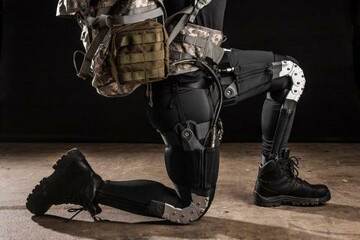Humanizing Exoskeletons for Soldiers, Workers and Paraplegics
CAMBRIDGE, MA—Exoskeletons are making it possible for people with paraplegia to stand up, walk and even climb steps. Like their fabled science fiction counterparts, these exosuits also show promise for granting soldiers and workers superhuman strength. Despite their potential, exoskeletons remain a technology that hasn’t quite caught on. The reason may be that most exosystems today are designed without considering the way humans interact with them.
Kevin Duda, an engineer in human systems integration at Draper, and Leia Stirling, an Assistant Professor and Co-director of the MIT Man Vehicle Lab, calls this design consideration the physical and cognitive fit.
In research led by Stirling, the researchers found that while exosystems are generally designed to negotiate stairs, increase endurance, increase strength, and regain function, “there are real complexities that arise as the automation creates new cognitive work for the wearer,” such as attention, workload and situational awareness, according to the paper.
Physical and cognitive fit are critical to improving the current approach to designing exosystem technologies—which has been identified as a gap in current methodologies—according to the research conducted by MIT and Draper. The researchers framed a series of questions to aid developers who design and assess exosystems. For example, what workload does the user experience when performing the functional task with the system? Does the system require significant attentional resources to interact with or command?
“Our aim is to identify and eliminate the barriers to a viable exoskeleton system and find a balance between the system’s sensing, control and actuation,” said Duda. “The ability for the exosystem to provide feedback to the human or adapt its response based on inferring the human’s intent is important for developing systems for environments of all kinds. The goal for all of us developing wearable assistance technologies is to deliver a high level of human-exosystem fluency.”
Stirling added: “It is not a trivial problem to develop these intent-based recognition controllers and incorporate multiple modes within an exoskeleton. These are open challenges that the community is beginning to examine.”
The journal article “Human Factors Considerations for Enabling Functional Use of Exosystems in Operational Environments” was written by Stirling in collaboration with Duda, Eric Jones, a human systems architect at Draper, and Ho Chit Siu, a research assistant at the MIT Man Vehicle Lab. The article is available online at IEEE Systems Journal.
Jones and Stirling explored this topic further in their paper “The Effect of a Powered Lower-Body Exoskeleton on Physical and Cognitive Warfighter Performance,” co-written with Draper Fellow and MIT graduate student Blake Bequette and Adam Norton of the University of Massachusetts Lowell’s New England Robotics Validation and Experimentation (NERVE) Center. In the study, the researchers analyzed 12 military members on a simulated patrol task in three modes: wearing a powered lower body exoskeleton, wearing the exoskeleton unpowered and not wearing the exoskeleton. Of the 12 subjects, eight had a higher reaction time on a visual reaction task when wearing the powered exoskeleton compared to without the exoskeleton—a finding that supports the idea that attention can be affected when wearing an exoskeleton and highlights the need to better understand cognitive fit to improve exoskeleton designs. The paper has been accepted for the 2018 annual meeting of the Human Factors and Ergonomics Society.
Creating human-centered solutions is one of Draper’s key capabilities. Draper technologies have aided soldiers in accurately landing parachutes and safely airdropping supplies into conflict zones. The current work in exosystem technologies is designed to support the increased demands faced by warfighters and to advance soldier technology in the next decade.
Released May 8, 2018

